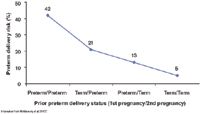Preterm birth: 3 keys to assessing risk
The process of parturition, both term and preterm, involves a uniquely coordinated interaction between the cervix and uterus.

Key Points
The process of parturition, both term and preterm, involves a uniquely coordinated interaction between the cervix and uterus. An unripened cervix can withstand prolonged periods of uterine contractions without manifesting change, but a ripened cervix may efface and dilate even in the presence of minimal uterine activity. This explains why contractions in and of themselves are such poor predictors of spontaneous preterm birth (PTB), although they are the factor that most often prompts patients to come in for evaluation. Alternatively, evidence has strongly confirmed that surrogate markers of cervical ripening or decidual activation, such as the presence of fetal fibronectin (fFN) in cervicovaginal secretions or cervical shortening on ultrasound (U/S), are superior to contractions alone in predicting PTB.1 (Ed: About 1 in 4 PTBs occur because of maternal and/or fetal indications, but for the purposes of this article, the abbreviation refers specifically to spontaneous PTB.)
A woman's true risk of PTB must be accurately assessed in order to target interventions to patients who are most likely to benefit. Doing so can also reduce unnecessary and costly interventions in women who actually have a low risk of PTB despite a high-risk history or symptoms of preterm labor. Currently, the most reliable ways to predict spontaneous PTB in both symptomatic and asymptomatic patients include eliciting a history of prior PTB, screening for fFN, and assessing cervical length (CL) with U/S. The landmark Preterm Prevention Study, in which nearly 3,000 asymptomatic gravid women were assessed at 22 to 24 weeks' gestation for risk factors for PTB, demonstrated that these 3 predictors conferred a far greater relative risk of PTB than other traditional factors associated with PTB, including uterine contractions.1
Recent and ongoing research is refining and expanding the prognostic capacity of these most effective predictive tools. This article describes novel ways to use and combine these predictive screening methods to derive a patient-specific PTB risk assessment across gestation. Such a tailored risk profile can help guide use of interventions such as progesterone supplementation and cerclage in selected asymptomatic patients at risk for PTB. Although multiple gestations clearly are associated with increased risk for PTB, this review focuses on studies pertaining to singleton gestations.
Enhanced obstetrical history as a predictor of future PTB
Prior PTB is associated with an increased risk of recurrent PTB, so a thorough obstetrical history is essential to identifying this population. Risk of recurrent PTB is further modified by the gestational age of the prior PTB (severity), the number of prior PTBs (frequency), and the order in which they occurred.2

